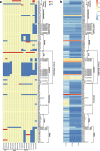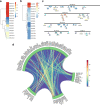Genomic landscape of prominent XDR Acinetobacter clonal complexes from Dhaka, Bangladesh
- PMID: 36471260
- PMCID: PMC9721023
- DOI: 10.1186/s12864-022-08991-x
Genomic landscape of prominent XDR Acinetobacter clonal complexes from Dhaka, Bangladesh
Abstract
Background: Acinetobacter calcoaceticus-A. baumannii (ACB) complex pathogens are known for their prevalence in nosocomial infections and extensive antimicrobial resistance (AMR) capabilities. While genomic studies worldwide have elucidated the genetic context of antibiotic resistance in major international clones (ICs) of clinical Acinetobacter spp., not much information is available from Bangladesh. In this study, we analysed the AMR profiles of 63 ACB complex strains collected from Dhaka, Bangladesh. Following this, we generated draft genomes of 15 of these strains to understand the prevalence and genomic environments of AMR, virulence and mobilization associated genes in different Acinetobacter clones.
Results: Around 84% (n = 53) of the strains were extensively drug resistant (XDR) with two showing pan-drug resistance. Draft genomes generated for 15 strains confirmed 14 to be A. baumannii while one was A. nosocomialis. Most A. baumannii genomes fell under three clonal complexes (CCs): the globally dominant CC1 and CC2, and CC10; one strain had a novel sequence type (ST). AMR phenotype-genotype agreement was observed and the genomes contained various beta-lactamase genes including blaOXA-23 (n = 12), blaOXA-66 (n = 6), and blaNDM-1 (n = 3). All genomes displayed roughly similar virulomes, however some virulence genes such as the Acinetobactin bauA and the type IV pilus gene pilA displayed high genetic variability. CC2 strains carried highest levels of plasmidic gene content and possessed conjugative elements carrying AMR genes, virulence factors and insertion sequences.
Conclusion: This study presents the first comparative genomic analysis of XDR clinical Acinetobacter spp. from Bangladesh. It highlights the prevalence of different classes of beta-lactamases, mobilome-derived heterogeneity in genetic architecture and virulence gene variability in prominent Acinetobacter clonal complexes in the country. The findings of this study would be valuable in understanding the genomic epidemiology of A. baumannii clones and their association with closely related pathogenic species like A. nosocomialis in Bangladesh.
Keywords: Acinetobacter baumannii; Acinetobacter nosocomialis; Clonal complex; Comparative genomics; WGS.
© 2022. The Author(s).
Conflict of interest statement
The authors have no competing interests to declare that are relevant to the content of this article.
Figures





References
MeSH terms
Substances
Grants and funding
LinkOut - more resources
Full Text Sources
Medical
Miscellaneous

